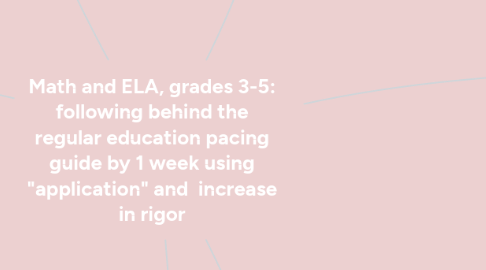
1. ELA
1.1. Writing
1.1.1. Category List: a new dimension to brainstorming: using a list of categories students add to their brainstorm list by considering different perspectives or points of view
1.1.2. Art Integration:has two broad goals: (1) To help teachers create rich connections between works of art and curricular topics; and (2) to help teachers use art as a force for developing students’ thinking dispositions.
1.1.3. Brainstorming: using the 4 rules to produce as many ideas as possible before evaluating them
1.2. Reading
1.2.1. Genius Hour: students' learning is driven by a topic they have chosen and are passionate about
1.2.2. SCAMPER: a creative thinking strategy that uses the acronym to encourage inventive ideas using their imagination (substitute, combine, adapt, modify/minify/magnify, put to other uses, eliminate, reverse/rearrange)
1.2.3. Simulations: used to teach content, thinking and reasoning skills necessary to solve real world problems. Can be done with games, role playing and simulations.
2. Chris Shroyer
3. Created using Mindmeister.com
4. Metacognitive Response
4.1. Content Relationship: the 8 strategies that I have chosen support either Math problem solving, Reading or Writing. I've listed them with where I believed they fit at first glance. After writing out the explanaition of each strategy I realize that they could all be moved and used in each of the other disciplines. When it comes to creative thinking and creative curriculum it can be utilized in all areas of learning.
4.2. Inspiring "Change": These new instructional strategies are wonderful resources that allow me to try new things which will allow our students to try new things. Change is good and I am excited about it.
5. Impact to Gifted Learners: Almost all of my students could learn a lot from these creative thinking strategies. I feel that they are so used to: being told answers; not being given a chance or the time to struggle; and they just "google" instead of allowing themselves to come up with ideas and answers. So, these strategies are going to be wonderful for my gifted students!
6. Math
6.1. Creative and Complex Problem Solving
6.1.1. Real World Problem Solving
6.1.1.1. Deals with Struggle
6.1.1.1.1. Growth Mindset: teaching students to believe that intelligence can be developed and that effort is the key to success; also, helping students thrive in the face of challenges
6.1.1.2. Wallas Model: Four stages of Creativity -divides the process of creative thinking into 4 stages. These stages are Preparation, Incubation, Illumination, and Verification. These stages allow students the most success with their creative thinking
6.1.2. June Maker Model: modifying the learning environment, content and product to allow students to have a responsive learning environment that promotes maximum learning about self, others and content

